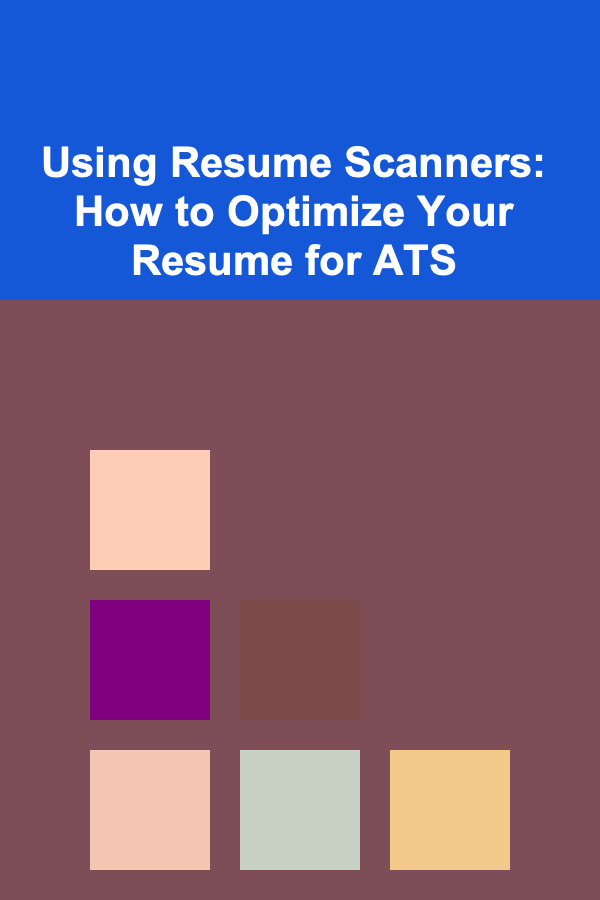
Using Resume Scanners: How to Optimize Your Resume for ATS
ebook include PDF & Audio bundle (Micro Guide)
$12.99$7.99
Limited Time Offer! Order within the next:

In today's competitive job market, submitting a resume is only one step in the hiring process. Many companies use Applicant Tracking Systems (ATS) to streamline the hiring process and help identify the best candidates for the job. These systems can automatically scan and filter resumes based on keywords, formatting, and other criteria before they even reach a hiring manager's eyes. As such, understanding how ATS works and optimizing your resume for these systems is crucial to improving your chances of landing an interview.
This guide will provide you with actionable steps on how to create an ATS-friendly resume, ensuring that it not only passes the scanner but also impresses recruiters once it reaches their hands.
What is an Applicant Tracking System (ATS)?
An Applicant Tracking System (ATS) is a software tool used by many organizations to manage the recruitment process. The system is designed to scan resumes, rank candidates, and filter them based on specific criteria set by the employer. It acts as a gatekeeper, ensuring that only resumes that meet certain requirements make it to the hands of the hiring manager.
ATS typically screens resumes by looking for keywords, phrases, and other relevant information like education, work experience, and skills. It also scans for proper formatting and compatibility to ensure that the resume is readable by the system.
For job seekers, the main challenge is that ATS often cannot interpret complex formatting, graphics, or non-standard fonts. Resumes that do not align with the system's requirements risk being overlooked, even if the candidate is highly qualified.
Why Optimizing Your Resume for ATS Matters
Optimizing your resume for ATS is not just about getting through the initial filter; it's about ensuring that your resume can effectively highlight your skills, experiences, and qualifications in a way that both the ATS and the hiring manager can easily understand.
The benefits of optimizing your resume for ATS include:
- Improved chances of getting noticed: An ATS-friendly resume ensures that your document will be properly parsed and ranked, improving the likelihood that it will be seen by a recruiter.
- Better alignment with job descriptions: Optimizing your resume helps you tailor it to each job you apply for, making it more likely to align with the role's specific requirements.
- Increased efficiency in job applications: Once you understand ATS optimization, you can more easily customize your resume for different roles and submit it with confidence.
Key Strategies for Optimizing Your Resume for ATS
1. Use a Simple, Clean Format
The design and formatting of your resume can have a significant impact on how well it performs with an ATS. Most ATS software has trouble parsing complex layouts with unusual fonts, images, or tables. To ensure that your resume is ATS-compatible, focus on the following:
- Use standard fonts: Stick to widely used fonts such as Arial, Calibri, or Times New Roman. Avoid fancy fonts or cursive styles, which may not be recognized by the system.
- Use standard resume sections: Label your sections clearly with headings like "Work Experience," "Education," "Skills," and "Certifications." ATS is designed to scan these headings, so using non-standard or creative labels can confuse the system.
- Avoid images, graphics, and charts: ATS systems cannot read images or interpret non-text elements. Keep your resume text-based to ensure it is parsed correctly.
- Use a .docx or PDF format: While some ATS systems can read PDFs, it's generally safer to submit your resume in .docx (Microsoft Word) format, as this is universally readable by ATS software.
2. Incorporate Relevant Keywords
ATS software relies heavily on keywords to filter resumes. These keywords are typically derived from the job description and may include specific skills, qualifications, or industry-related terms. By incorporating relevant keywords into your resume, you increase the chances of your document passing the ATS filters.
- Analyze the job description: Look for specific words or phrases used in the job listing, such as required skills, certifications, or tools. For example, if the job requires "project management" experience or proficiency in "JavaScript," these terms should appear in your resume where applicable.
- Use variations of keywords: ATS systems may look for different versions of the same term. For example, a job listing may mention "data analysis," but an ATS may also be programmed to look for "data analytics." Using both variations can increase your chances of being flagged by the ATS.
- Incorporate industry terms: Use terms that are specific to your industry or role. If you're applying for a marketing position, terms like "SEO," "content strategy," or "digital marketing" should be included if they match your experience.
3. Tailor Your Resume for Each Job
A one-size-fits-all resume is unlikely to perform well with ATS. Instead, tailor your resume for each position you apply to by aligning it closely with the specific requirements listed in the job description.
- Focus on the most relevant skills: Highlight the skills and experiences that directly align with the role you're applying for. If the job requires a specific software tool or technology, make sure to mention your proficiency in that area.
- Adjust your job titles: Sometimes, ATS systems are sensitive to job titles. If you've held a similar role with a different title, consider modifying the title on your resume to match the one in the job description. For example, if the listing says "Marketing Manager," but your previous role was "Marketing Lead," you might want to use "Marketing Manager" in your resume (provided it reflects your actual duties).
- Use the exact wording from the job description: If the job posting uses a specific phrase like "team collaboration" or "customer support," try to mirror that language in your resume to improve the chances that the ATS will flag your resume.
4. Focus on Key Sections: Experience, Skills, and Education
Certain sections of your resume are particularly important when optimizing for ATS. These sections need to be easily identifiable and contain the most relevant information.
- Work Experience: Ensure that your job titles, company names, and employment dates are listed clearly. Use bullet points to describe your responsibilities and accomplishments, and incorporate relevant keywords where appropriate.
- Skills Section: Include a separate section for your hard and soft skills, making sure to highlight those that are relevant to the job. Don't be afraid to list technical skills like software proficiency, coding languages, or certifications.
- Education: Include your degree, institution, and graduation date. If the job requires specific education or certifications, make sure to list them clearly in this section.
5. Use Action Verbs and Quantifiable Achievements
ATS systems look for strong, active language in resumes. Using action verbs such as "led," "developed," "achieved," or "designed" can make your resume stand out to both the ATS and the hiring manager.
- Show quantifiable results: Whenever possible, use numbers to highlight your achievements. For example, instead of saying "Managed social media campaigns," say "Managed social media campaigns that increased engagement by 30%." This gives both the ATS and the hiring manager a clear picture of your impact.
6. Avoid Unnecessary Sections or Information
Certain information may be irrelevant to an ATS and could cause unnecessary complications in how your resume is parsed.
- Personal information: Avoid including personal details like your age, gender, marital status, or social security number, as these will not add any value to your application.
- Hobbies or interests: While hobbies may add personality to your resume, they are unlikely to improve your chances of passing the ATS. Focus on professional accomplishments and skills instead.
- References: Instead of listing "References available upon request," save that space for more valuable information. Hiring managers will ask for references when needed.
7. Test Your Resume with ATS Tools
There are several online tools that allow you to test how well your resume performs with ATS software. Tools like Jobscan or Resumake can help you assess whether your resume is ATS-friendly and offer suggestions for improvement.
- Use ATS simulators: These tools analyze your resume and compare it to a specific job description, giving you insights into how well your resume matches the required keywords and formatting.
- Optimize based on feedback: Take the feedback from ATS simulators to adjust your resume. If the tool suggests you include certain keywords or reformat your resume, make the necessary changes.
Final Thoughts
Optimizing your resume for ATS is an essential step in today's job search process. By using the right keywords, formatting your resume simply and clearly, and tailoring it to each job description, you can improve your chances of passing ATS filters and getting noticed by recruiters.
Remember, the goal is not just to "beat" the system but to ensure that your qualifications and experience are presented in the best possible way, making it easier for both the ATS and the hiring manager to see that you're a great fit for the job. By following these actionable strategies, you'll be well on your way to optimizing your resume for ATS success and securing your next job.
Reading More From Our Other Websites
- [Personal Finance Management 101] How to Implement the 50/30/20 Budget Rule for Financial Stability
- [Home Rental Property 101] How to Attract Long-Term Tenants to Your Rental Property
- [Home Rental Property 101] How to Handle the End of a Lease Agreement and New Tenant Onboarding
- [Organization Tip 101] What Should You Consider When Creating a Cozy Reading Nook?
- [Home Soundproofing 101] How to Soundproof a Room for Virtual Meetings
- [Toy Making Tip 101] Step-by-Step Tutorial: Sewing and Assembling a Classic Cloth Doll
- [Organization Tip 101] How to Maintain and Clean Stenciled Walls for Long-Lasting Beauty
- [Organization Tip 101] How to Set Up a System for Organizing Home Repair Receipts
- [Star Gazing Tip 101] From Deserts to Mountains: The Ultimate Guide to the Best Stargazing Locations
- [Organization Tip 101] How to Properly Apply Low VOC Paint for Long-Lasting Results

Building an Engaging Content Portfolio as a Content Editor
Read More
How to Create a Rental Lease Agreement That Protects Both Parties
Read More
How to Incorporate Greenery and Garlands into Your Holiday Decor
Read More
How to Make Use of Vertical Space in Your Living Room
Read More
How to Set Up an Ideal Pet Play Area at Home
Read More
How to Make Your Home Energy Independent
Read MoreOther Products

Building an Engaging Content Portfolio as a Content Editor
Read More
How to Create a Rental Lease Agreement That Protects Both Parties
Read More
How to Incorporate Greenery and Garlands into Your Holiday Decor
Read More
How to Make Use of Vertical Space in Your Living Room
Read More
How to Set Up an Ideal Pet Play Area at Home
Read More